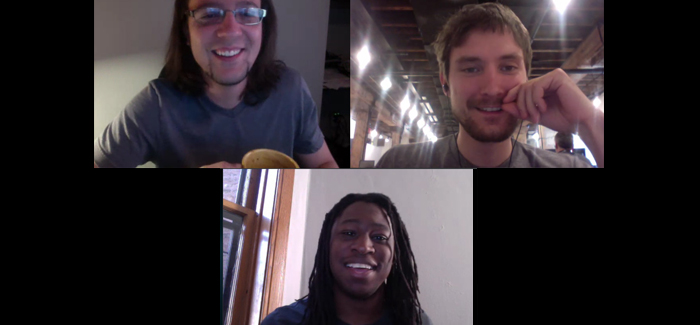
Cody, Schires, and Walsh (clockwise from top left) manage Scholastica via Skype. (Photos courtesy Scholastica)
Three alumni develop an online platform to streamline the path to publication.
As a sociology PhD student in 2007, Brian Cody, AM’08, was thinking about publishing a paper. “If you write this,” a professor told him, “we can probably get this published in two years.” A journal’s volunteer peer reviewers might take four months or more to read an article, then Cody would have to rewrite, and then the journal had to be printed. Cody’s professor said, “That’s just the way it works.”
Rob Walsh, AM’07, saw the flip side while working as an editorial assistant at one of Johns Hopkins University Press’s English journals. Walsh helped manage the stacks of submitted manuscripts, all stored in filing cabinets. Once, Walsh says, a professor from Harvard asked after his paper, which he had submitted about a year before. Walsh looked in the files and discovered that it was never sent to reviewers.
“The way scholarly publishing works is an accepted evil,” says Cody. To change it, he cofounded Scholastica, a web-based publishing platform and review-management system. With Walsh and Cory Schires, AM’07, both graduates of the Master of Arts Program in the Social Sciences (MAPSS), Cody is creating an infrastructure for editors and authors to manage submissions and peer reviews, plus a cloud-based, open-access platform that allows articles to be published as soon as possible. Says Cody: “We’re hoping to be like a Tumblr platform for academic publishing.”
The founders share a philosophy—to a point—with the late Aaron Swartz, the Internet activist who aimed to make knowledge more accessible. (Starting in late 2010, the 23-year-old Swartz took his activism a step beyond the legal line by downloading millions of articles from JSTOR, a digital library of academic publications, using the Massachusetts Institute of Technology’s campus network, with the alleged goal of distributing the articles for free.) The difference between Scholastica’s objective and Swartz’s, says Cody, is that Scholastica not only wants to change how knowledge is distributed but also the supply chain in which it is created: “We want to work with the content producers within academia to give them the infrastructure they need to have total control over the creation and dissemination of their knowledge.”
Their system seeks to streamline the publishing process, which they say can be cut to just two to three months. “A big part of the time is publishing—copyediting, layout, printing,” says Cody. “You can cut at least a month off that just by putting the journal online.”
Scholastica, which launched in 2011 and left the beta stage in early 2012, works with more than 60 journals, including the University of Chicago Law Review; the California Law Review; and the Journal of Religion, Identity, and Politics at the University of Denver and Iliff School of Theology. Many of the journals now accept submissions solely through Scholastica. The cost (paid directly to Scholastica): $5 for submissions to law reviews and $10 for submissions to journals in any other field, paid for by either the author or an institution on their behalf.
Schires says the Scholastica cofounders targeted prestigious publications to build the platform’s reputation. Almost right away, law journals jumped on the bandwagon. Law reviews can get thousands of submissions—unlike in other academic fields, authors can submit to more than one at a time—and Scholastica provides a way for the editors to easily read and debate each submission, all making notes in one place, unlike the reigning online submission system for law reviews, ExpressO.
Because submission fees add up, the $5 Scholastica charge—about $3 more than ExpressO—caused a small uproar among legal bloggers. Mike Madison, a professor at the University of Pittsburgh School of Law, worried on Madisonian.net that, because Scholastica “is private, and revenue-dependent,” schools and individual scholars are always going to have to pay.
A key advantage of Scholastica: many existing journal management programs, Walsh says, amount to a “piece of software in a box that doesn’t change.” Walsh, Cody, and Schires, all self-trained programmers, update their software regularly.
The three see themselves fighting alongside scholars and institutions to fix a broken publishing system. They regularly talk to journal editors and authors about what kinds of features would make their lives easier, and then debate the best ways to implement them. In March the company launched a beta version of Scholastica Analytics, a page where editors can see key metrics about their journals, such as average number of days to manuscript decisions and acceptance rate.
While Walsh and Schires still live in Chicago, Cody—who decided in late 2012 to leave the PhD program to focus on Scholastica full time—moved to Phoenix with his wife. But every day they’re together. After a morning “scrum,” a common tech company practice to make quick decisions, they stay on Skype all day. “We’ll all be on mute,” says Walsh, but “it’s like they’re in the same room.”
Scholastica is also working on a kind of matchmaking service to help journals find reviewers and vice versa, which they hope will allow other academics—and tenure boards—to see the quality of each reviewer. “It proves a contribution to knowledge,” says Cody.
The three foresee 2013 being their first profitable year. In one week in February, 1,000 new users signed up. But creating the technology is an iterative process that cannot be rushed. Even in its earliest versions, though, journal editors have expressed appreciation for the way Scholastica streamlines publishing. “One editor said that this has been his most efficient period ever,” says Cody. “That’s what we want.”
